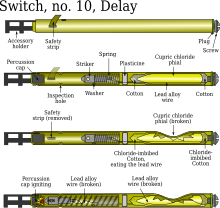Time fuse

Time detonators detonate an explosive charge after a certain, predetermined time.
A distinction can be made between pyrotechnic , mechanical , chemical and electronic detonators.
Pyrotechnic time detonators
The delay can be achieved by burning a fuse .
In the case of hand grenades , the delay rate detonates the object after a time interval (time stamp) usually set at the factory, regardless of the time of impact. They are more widespread than impact fuses because of their safer handling . For the implementation of the time interval (burn-off) there are different solutions depending on the respective state of the art. In general, delay times between four and five seconds are common in modern models (old models from the First World War , such as the tear gas grenade US M54 CS-HGR, needed between 8 and 12 seconds to build up pressure). The trigger is an event that is triggered when the soldier leaves the weapon. Towards the beginning of the century, these were often leather loops, later mostly releasable safety brackets, which activated the actual mechanism with the help of spring springs.
Mechanical time fuse
Mechanical time detonators usually work with a spring mechanism, comparable to a pocket watch . At a predetermined point in time from the start of the mechanism, the detonation of the explosive device is triggered. Since mechanics make noises, you can often recognize them by a typical ticking. The time of ignition can be determined approximately, but not exactly, since mechanical components have material-related fluctuations (tolerances). The first bomb to be fitted with a mechanical time fuse was accidentally detonated while being loaded onto the Mosel emigrant ship in Bremerhaven in 1875.
Chemical time detonators
Chemical time detonators work on the basis of two chemical substances that react slowly with one another and trigger an initial ignition . In contrast to other detonators, a chemical timer cannot be stopped or canceled; in addition, the time of ignition cannot be precisely determined. The latter is due to the way it works. In contrast to most detonators, which are influenced by the ambient temperature at most through icing , the temperature is an essential factor with chemical detonators. The chemical reaction proceeds more slowly at low temperatures, and correspondingly faster at high temperatures. Probably the best known example of the use of a chemical time fuse was the assassination attempt of July 20, 1944 on Adolf Hitler , where a pencil detonator (official name: Switch No. 10) of British origin was used. A copper (II) chloride solution was located in a thin-walled brass tube in a glass ampoule wrapped with cotton fabric. After crushing the ampoule by kinking the tube, the chloride solution erodes the holding wire of the cocked firing pin , which is located in the fabric cover , which then strikes a primer with the initial charge and thus triggers the actual explosive charge. During the Second World War , these detonators, which cannot be defused after activation, were e. B. also used in the French Resistance in acts of sabotage.
The chemical-mechanical long-term detonators of British and American aerial bombs work on a similar principle, and their delayed explosion is intended to hinder fire-fighting and rescue work. Here the firing pin was held by a pack of celluloid plates. The trigger spindle, which was driven by the wind turbine when the bomb fell, destroyed the acetone glass ampoule screwed into the detonator . This disintegrated the plates and the firing pin triggered. The delay times could vary between a few dozen minutes and several days by using a different number of platelets of different thickness. The detonators are colloquially incorrectly referred to as acid detonators , although the solvent used, acetone, is one of the ketones and is therefore not chemically an acid .
Bombs that are equipped with such detonators, as duds , still represent a particularly great danger today because they can explode at any time even without external influence due to the aging-related decrease in strength of the celluloid.
Electronic time detonators
Electronic time detonators are the "modern" version of mechanical detonators. They work on the basis of an electronic circuit , one after a predetermined time electric power turns on ( "triggers") , which in turn the explosive charge is ignited. The point in time of the explosion can thus be determined with approximately a second.
Individual evidence
- ↑ Beat Kneubuehl (ed.), Robin Coupland, Markus Rothschild , Michael Thali: Wundballistik. Basics and Applications. 3. Edition. Springer, 2008, ISBN 978-3-540-79008-2 . P. 58 [1]
- ↑ Unsuccessful assassination attempt in Bremerhaven - the first time bomb in the world shakes the city in 1875 - Bremerhaven.de. December 10, 2011, accessed August 5, 2019 .
- ↑ Wolfgang Michel: British special weapons 1939-1945: Equipment for elite units, secret service and resistance . BOD, 2011. ISBN 9783842339446 .


